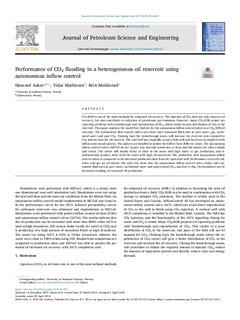| dc.contributor.author | Aakre, Haavard | |
| dc.contributor.author | Mathisen, Vidar | |
| dc.contributor.author | Moldestad, Britt Margrethe Emilie | |
| dc.date.accessioned | 2018-10-29T10:01:32Z | |
| dc.date.available | 2018-10-29T10:01:32Z | |
| dc.date.created | 2018-10-24T17:00:14Z | |
| dc.date.issued | 2018 | |
| dc.identifier.citation | Journal of Petroleum Science and Engineering. 2018, 167, 654-663. | nb_NO |
| dc.identifier.issn | 0920-4105 | |
| dc.identifier.uri | http://hdl.handle.net/11250/2569907 | |
| dc.description | This is an open access article under the CC BY-NC-ND license. | nb_NO |
| dc.description.abstract | CO2-EOR is one of the main methods for enhanced oil recovery. The injection of CO2 does not only improve oil recovery, but also contributes to reduction of greenhouse gas emissions. However, many CO2-EOR project are reporting problems with breakthrough and reproduction of CO2, which results in poor distribution of CO2 in the reservoir. This paper analyzes the world first trial test for the autonomous inflow control valves in a CO2-EOR oil reservoir. The autonomous flow control valves can choke back unwanted fluid such as pure water, gas, carbonized water and pure CO2. Choking back the breakthrough zones, will increase the reservoir area exposed for CO2 and increase the oil recovery. The trial well was originally an open hole well and has been recompleted with inflow control and packers. The packers are installed to isolate the well in three different zones. The autonomous inflow control valves (AICVs) do not require any external connection or force and this makes the valves simple and robust. The valves will locally choke or close in the zones with high water or gas production, and simultaneously produce more from the zones with high oil saturation. The production with autonomous inflow control valves is compared to the historical production data from the open-hole well. Performance curves for oil, water and gas are presented. The trial tests show that the autonomous inflow control valve chokes back unwanted fluid such as pure water, carbonized water and supercritical CO2, and due to this, the drawdown can be increased resulting in increased oil production.Simulations were performed with NETool, which is a steady state one dimensional near well simulation tool. Simulations were run using the trial well data and the reservoir conditions from the Midale field. An autonomous inflow control model implemented in NETool was tuned to fit the performance curves for the AICV. Relative permeability curves for carbonate reservoirs was estimated and implemented in NETool. Simulations were performed with passive inflow control devices (ICDs) and autonomous inflow control valves (AICVs). The results indicate that the oil production can be increased with more than 400% when AICV is used at high drawdown. ICD cannot choke locally for water or CO2, and is producing very high amount of unwanted fluids at high drawdown. The water cut using AICV is 65% at 50 bar drawdown whereas the water cut is close to 100% when using ICD. Results from simulations are compared to production data, and NETool was able to predict the potential of increased oil recovery with AICV completion well. | nb_NO |
| dc.description.abstract | Performance of CO2 flooding in a heterogeneous oil reservoir using autonomous inflow control | nb_NO |
| dc.language.iso | eng | nb_NO |
| dc.publisher | Published by Elsevier B.V. | nb_NO |
| dc.rights | Attribution-NonCommercial-NoDerivatives 4.0 Internasjonal | * |
| dc.rights.uri | http://creativecommons.org/licenses/by-nc-nd/4.0/deed.no | * |
| dc.title | Performance of CO2 flooding in a heterogeneous oil reservoir using autonomous inflow control | nb_NO |
| dc.title.alternative | Performance of CO2 flooding in a heterogeneous oil reservoir using autonomous inflow control | nb_NO |
| dc.type | Journal article | nb_NO |
| dc.type | Peer reviewed | nb_NO |
| dc.description.version | publishedVersion | nb_NO |
| dc.rights.holder | © 2018 The Authors. | nb_NO |
| dc.source.pagenumber | 654-663 | nb_NO |
| dc.source.volume | 167 | nb_NO |
| dc.source.journal | Journal of Petroleum Science and Engineering | nb_NO |
| dc.identifier.doi | 10.1016/j.petrol.2018.04.008 | |
| dc.identifier.cristin | 1623231 | |
| cristin.unitcode | 222,58,3,0 | |
| cristin.unitname | Institutt for prosess-, energi- og miljøteknologi | |
| cristin.ispublished | true | |
| cristin.fulltext | original | |
| cristin.qualitycode | 2 | |

